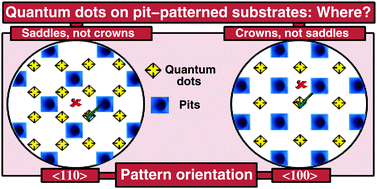当前位置:
X-MOL 学术
›
Phys. Chem. Chem. Phys.
›
论文详情
Our official English website, www.x-mol.net, welcomes your feedback! (Note: you will need to create a separate account there.)
Orientational competition in quantum dot growth in Si–Ge heteroepitaxy on pit-patterned Si(001) substrates
Physical Chemistry Chemical Physics ( IF 3.3 ) Pub Date : 2020/03/12 , DOI: 10.1039/d0cp00542h Gopal Krishna Dixit 1, 2, 3, 4 , Monika Dhankhar 1, 2, 3, 4 , Madhav Ranganathan 1, 2, 3, 4
Physical Chemistry Chemical Physics ( IF 3.3 ) Pub Date : 2020/03/12 , DOI: 10.1039/d0cp00542h Gopal Krishna Dixit 1, 2, 3, 4 , Monika Dhankhar 1, 2, 3, 4 , Madhav Ranganathan 1, 2, 3, 4
Affiliation

|
Towards precisely controlled nanostructure growth, patterned substrates are used as templates to direct heteroepitaxial self-assembly. This affects the size, shape and ordering of nanostructures, which are formed as a consequence of the mismatch in strain. In the well-studied case of Si–Ge heteroepitaxy on Si, the lattice mismatch leads to spontaneous formation of quantum dots. On patterned substrates, the competition between the length scale of the pattern and the intrinsic quantum dot size leads to rich behavior, where the localization of dots can be modified with respect to the features of the patterns. We show by continuum modeling that, in cubic elastic materials such as silicon and germanium, there is also a competition between the pattern orientation and the elastically soft directions of the film, which affects the precise location of quantum dots on the surface. When the pattern is between the elastically soft directions, the quantum dots can form purely in the narrow region directly between two neighboring pits, referred to as the saddle region. On the other hand, when the pattern is along the elastically soft directions, the quantum dots prefer to form in the region at the centre of four pits, referred to as the crown region. This resolves a discrepancy between theory and experiments and gives another dimension to control quantum dot formation in strained nanocrystalline systems.
中文翻译:

凹坑图案化Si(001)衬底上Si-Ge异质外延量子点生长的取向竞争
为了精确控制纳米结构的生长,将有图案的基材用作模板来指导异质外延自组装。这会影响由于应变失配而形成的纳米结构的尺寸,形状和有序性。在经过充分研究的Si-Ge异质外延情况下,晶格失配会导致自发形成量子点。在图案化的基板上,图案的长度尺度与固有量子点尺寸之间的竞争导致了丰富的行为,在这种行为中,可以根据图案的特征来修改点的位置。我们通过连续模型表明,在立方弹性材料(例如硅和锗)中,图案的方向和薄膜的弹性软方向之间也存在竞争,这会影响量子点在表面上的精确位置。当图案在弹性软方向之间时,量子点可以纯粹在直接在两个相邻凹坑之间的狭窄区域中形成,称为鞍形区域。另一方面,当图案沿着弹性软的方向时,量子点优选形成在四个凹坑的中心区域中,称为冠状区域。这解决了理论与实验之间的差异,并为控制应变纳米晶体系统中的量子点形成提供了另一个维度。当图案沿着弹性软方向时,量子点更喜欢在四个凹坑中心的区域中形成,称为冠状区域。这解决了理论与实验之间的差异,并为控制应变纳米晶体系统中的量子点形成提供了另一个维度。当图案沿着弹性软方向时,量子点倾向于在四个凹坑中心的区域中形成,称为冠状区域。这解决了理论与实验之间的差异,并为控制应变纳米晶体系统中的量子点形成提供了另一个维度。
更新日期:2020-04-08
中文翻译:

凹坑图案化Si(001)衬底上Si-Ge异质外延量子点生长的取向竞争
为了精确控制纳米结构的生长,将有图案的基材用作模板来指导异质外延自组装。这会影响由于应变失配而形成的纳米结构的尺寸,形状和有序性。在经过充分研究的Si-Ge异质外延情况下,晶格失配会导致自发形成量子点。在图案化的基板上,图案的长度尺度与固有量子点尺寸之间的竞争导致了丰富的行为,在这种行为中,可以根据图案的特征来修改点的位置。我们通过连续模型表明,在立方弹性材料(例如硅和锗)中,图案的方向和薄膜的弹性软方向之间也存在竞争,这会影响量子点在表面上的精确位置。当图案在弹性软方向之间时,量子点可以纯粹在直接在两个相邻凹坑之间的狭窄区域中形成,称为鞍形区域。另一方面,当图案沿着弹性软的方向时,量子点优选形成在四个凹坑的中心区域中,称为冠状区域。这解决了理论与实验之间的差异,并为控制应变纳米晶体系统中的量子点形成提供了另一个维度。当图案沿着弹性软方向时,量子点更喜欢在四个凹坑中心的区域中形成,称为冠状区域。这解决了理论与实验之间的差异,并为控制应变纳米晶体系统中的量子点形成提供了另一个维度。当图案沿着弹性软方向时,量子点倾向于在四个凹坑中心的区域中形成,称为冠状区域。这解决了理论与实验之间的差异,并为控制应变纳米晶体系统中的量子点形成提供了另一个维度。

























 京公网安备 11010802027423号
京公网安备 11010802027423号